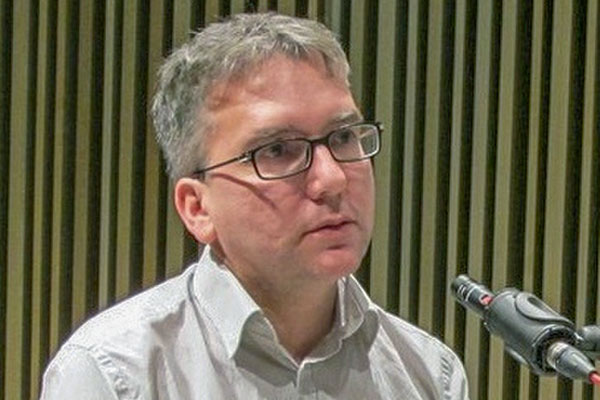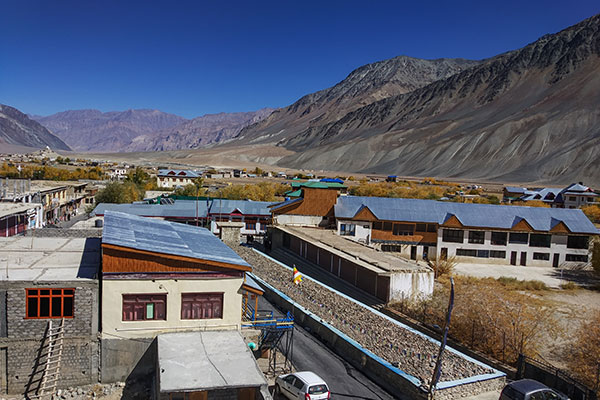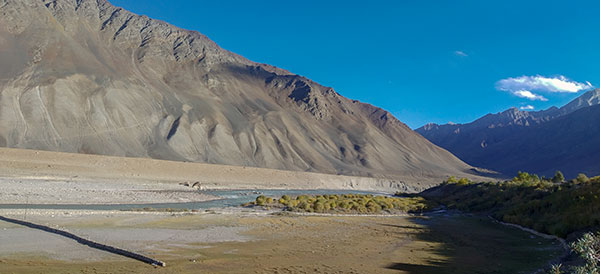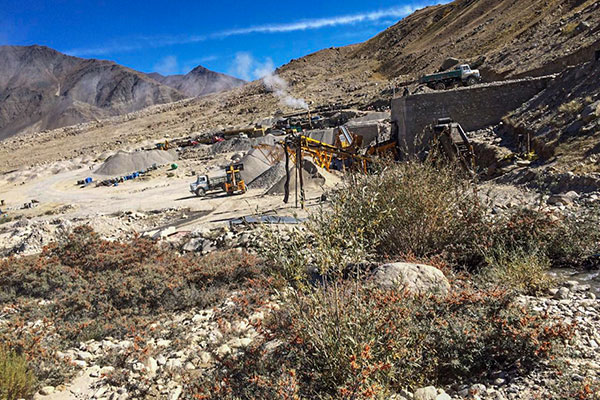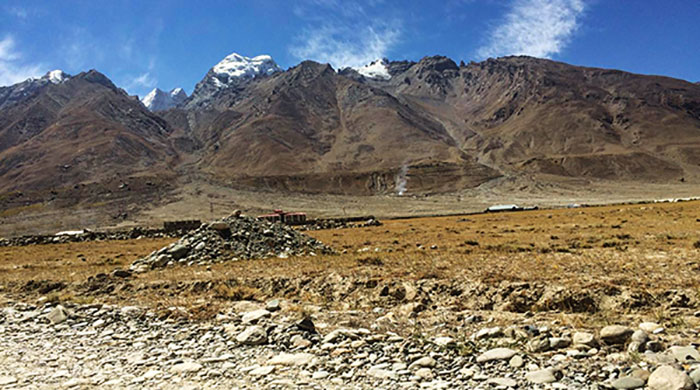The nomenclature ‘Bhoti’ is a Sanskrit term that is said to have been coined by a group of Tibetology scholars around five decades back with reference to the widely spread Himalayan cultural, liturgical and literary language. However, it actually denoted the script invented by Thonmi Sambhota—the able minister of King Songtsan Sgampo of Tibet—who adapted it from the Brahmi script at Nalanda (Indian subcontinent) in the Seventh Century. The main reason for calling the Himalayan language ‘Bhoti’ was to increase the importance of the proposal for recognition of the language under the Eight Schedule of the Indian Constitution.
Scholars in Ladakh, however, are split on this idea. One group claims that ‘Bhoti’ refers to Classical Tibetan as the religious and cultural language of the people of the Himalayan region stretching from Baltistan to Arunachal Pradesh. They support the use of ‘Bhoti’ for literary purposes and constitutional recognition. Others champion the use of ‘Ladakhi’ for recognition. They argue that it is a language that belongs to the Tibeto-Burman language group of the Sino-Tibetan language family that is spoken across the Himalayan region with regional variations and names. The language group includes Balti in Baltistan, Ladakhi in Ladakh, Lahuli in Lahul and Spiti, Bhutia in Sikkim, and Tamang and Lepcha in Arunachal Pradesh.
On the one hand, we have scholars such as Assistant Professor at Central University of Jharkhand, Ranchi, Dr. Konchok Tashi who terms this bond as “broader identity formation” that links diverse communities of the Himalayan region though none of them formally refer to their language as ‘Bhoti’. On the other hand, we have scholars such as Former Director of Culture Academy, Leh, Nawang Tsering Shakspo who disagrees with the use of the term ‘Bhoti’. He argues that a language by the name of ‘Bhoti’ does not exist and it is best to push for inclusion of the language spoken in Ladakh as ‘Ladakhi’.
He explained, “I had approached Sahitya Akademi—India’s National Academy of Letters—for recognition of Ladakhi as an Indian language in 1980. My submission was received favourably. The General Council of Sahitya Akademi had agreed in principle to grant recognition to Ladakhi along with Awadhi as Indian languages subject to availability of funds from the government. If all lovers of Ladakhi language, (or Bhoti for the matter) had supported my submission at the time and desisted from championing Bhoti, Ladakhi would have been recognised as an Indian language and many Ladakhi writers and scholars would have received recognition through prestigious Sahitya Akademi awards.”
With regard to the effort to gain recognition under ‘Bhoti’, Nawang Tsering Shakspo explained, “In the meantime, the Himalayan Buddhist Cultural Association, New Delhi, was promoting the Bhoti issue with vigour. Its leader, Lama Chosphel Zodpa was appointed as a Member of the Minorities Commission and he managed to push this issue to a fairly high level. He received support from several prominent leaders, including Union Ministers such as the late George Fernandes. The Central Institute of Indian Languages (CIIL), Mysore was thus obliged to send a team of linguists to conduct a socio-linguistic survey of Bhoti language across the Himalayan region. The team was led by Deputy Director of CIIL, Mysore, Prof. Rajesh Sachdeva. They started their survey from Ladakh in September 2008 and visited other Himalayan states through to March 2009. The survey team visited many households in Leh to check how many people called their mother tongue ‘Bhoti’. They were amazed to find that a negligible number of Ladakhis used the term ‘Bhoti’. On the final day of the survey in Ladakh, Prof. Rajesh Sachdeva convened a meeting of Ladakhi writers and scholars to gather feedback on their work.”
He explained that the meeting opened with a welcome speech by the then Director of Central Institute of Buddhist Studies, Leh, Dr Nawang Tsering. He narrated, “In his speech, the director said that according to language surveys conducted in India prior to 1900, there were around 10,000 people who spoke Ladakhi and by 1980, this number had increased to 110,000. He then added that ‘Your demand is to call this language Bhoti and wipe out the name of Ladakhi. If you succeed, then in the near future, there will be a question about the fate of the Ladakhi speakers recorded earlier!”
I had assumed that Sikkimese Bhutias would support the demand for recognition of Bhoti as the two names are somewhat similar. However, in a letter to Himalayan Buddhist Cultural Association, New Delhi, which was signed by the Special Secretary, Home Department, Government of Sikkim and dated 22 January, 2007, they wrote, “Bhutia language should be considered for inclusion in the Eight schedule of the Constitution”.
Similarly, Ladakhi language was formally recognised as ‘Ladakhi’ in the Sixth Schedule of the erstwhile state of Jammu & Kashmir through the 1951 rule adopted by the first State Re-organisation Commission to give state-level recognition for languages spoken by 70% of a district’s population.
In its issue of 6 March, 2008, Outlook Magazine carried the following report, “The ruling Sikkim Democratic Front government today demanded the inclusion of Bhutia (Bhooti), Lepcha and Limboo languages in the Eighth Schedule of the Constitution. A resolution seeking the inclusion of the languages in the Eighth Schedule was moved by the Human Resources Development Minister, Garjaman Gurung in the Assembly. The resolution was adopted unanimously.” It goes on to mention that the state government sought to justify the resolution on the grounds that the three indigenous languages are widely spoken and taught in schools and colleges across the state, and are recognised as official languages of the state. The article added that the state government intended to send a proposal to Government of India for recognition of these languages.
Thus, three major so-called Bhoti speaking ethnic groups in the North-eastern Himalayan region have already proposed that their languages be recognised as their own names. This is backed by a resolution passed by the Sikkim Legislative Assembly. Despite this, we in Ladakh seem to be imposing the name ‘Bhoti’ on all the ethnic groups in the Northeast. How will this benefit Ladakh?
Bhoti might provide an overarching framework to bring together the Indian Himalayan regions. However, if Ladakhi is recognised under ‘Bhoti’ it will lead to several challenges. Since ‘Bhoti’ refers to the cultural, religious and literary language of Classical Tibetan, most Ladakhis hesitate to use it to refer to their language. Furthermore, Ladakh’s Muslim community would have reservations about the language if it is called ‘Bhoti’ as it seems associated with Buddhism. On the other hand, the name ‘Ladakhi’ provides self-identification and a sense of proprietorship over the language that we speak in Ladakh.
The Sikkimese government has already given recognition to ‘Bhutia’ and it is taught in its educational institutions. Bhutia scholar, Bhaichung Tshering Bhutia has written, “It was in 1977 that Government of Sikkim recognised Bhutia language as one of the official languages and introduced it in schools of Sikkim. In 1987, the CBSE recognised Bhutia language at the Secondary and Senior Secondary levels. After that the North Bengal University recognised Bhutia language as one of the major Indian languages in the colleges of Sikkim from the academic session 2000-2001. In 2008, it was introduced as an elective subject in colleges across Sikkim under Sikkim Central University.” In 2016, it also introduced a master’s course in Bhutia.
It addition to these two schools of thoughts, there are some scholars in Ladakh who advocate for use of the term ‘Tibetan’ for Ladakhi. If this is accepted, it would create new political challenges and have literary implications. Tibetan language has already been granted affiliation by CBSE as ‘Tibetan’ and it will cause confusion if the language we speak is recognised under the same name.
In 2023, Ladakh would have an estimated 300,000 Ladakhi speakers along with its own TV and radio channels that broadcast in Ladakhi. Likewise, Ladakh also has had several periodicals such as Ladags Phonya, Ladakh Sargyur, Ladags Melong, Ladakh Studies, and Reach Ladakh Bulletin. Over the years, people in Ladakh have produced hundreds of feature films and song albums in Ladakhi. Similarly, over 300 books in Ladakhi have been published by the J&K Academy of Art, Culture and Languages.
Having considered all these arguments, I support the use of the term ‘Ladakhi’ to describe our language in the proposal for recognition under the Eight Schedule of the Indian Constitution. I doubt any other name will help keep our ethnic group and language identity intact in the future.
By Khanpo K. Sherab
Khanpo K. Sherab is Research OfficeratSongtsen Library, Center for Tibetan and Himalayan Studies, Dehradoon.


